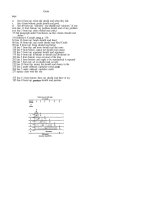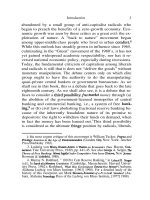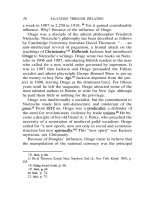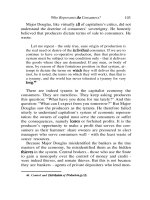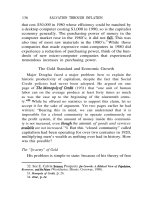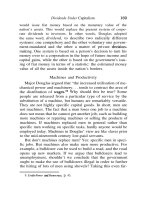Rediscovering social economics
Bạn đang xem bản rút gọn của tài liệu. Xem và tải ngay bản đầy đủ của tài liệu tại đây (3.41 MB, 198 trang )
Pe r s p e c t i v e s f r o m S o c i a l E c o n o m i c s
R E D I S C OV E R I N G
SOCIAL ECONOMICS
B E YO N D T H E
N E O C L A S S I C A L PA R A D I G M
ROGER D. JOHNSON
www.ebook3000.com
Perspectives from Social Economics
Series Editor
Mark D. White
City University of New York
College of Staten Island, Staten Island, USA
The Perspectives from Social Economics series incorporates an explicit
ethical component into contemporary economic discussion of important
policy and social issues, drawing on the approaches used by social economists around the world. It also allows social economists to develop their
own frameworks and paradigms by exploring the philosophy and methodology of social economics in relation to orthodox and other heterodox
approaches to economics. By furthering these goals, this series will expose
a wider readership to the scholarship produced by social economists, and
thereby promote the more inclusive viewpoints, especially as they concern
ethical analyses of economic issues and methods.
More information about this series at
/>
www.ebook3000.com
Roger D. Johnson
Rediscovering Social
Economics
Beyond the Neoclassical Paradigm
Roger D. Johnson
Mechanicsburg, Pennsylvania
USA
Perspectives from Social Economics
ISBN 978-3-319-51264-8
ISBN 978-3-319-51265-5 (eBook)
DOI 10.1007/978-3-319-51265-5
Library of Congress Control Number: 2017930487
© The Editor(s) (if applicable) and The Author(s) 2017
This work is subject to copyright. All rights are solely and exclusively licensed by the Publisher,
whether the whole or part of the material is concerned, specifically the rights of translation,
reprinting, reuse of illustrations, recitation, broadcasting, reproduction on microfilms or in any
other physical way, and transmission or information storage and retrieval, electronic adaptation,
computer software, or by similar or dissimilar methodology now known or hereafter developed.
The use of general descriptive names, registered names, trademarks, service marks, etc. in this
publication does not imply, even in the absence of a specific statement, that such names are
exempt from the relevant protective laws and regulations and therefore free for general use.
The publisher, the authors and the editors are safe to assume that the advice and information in
this book are believed to be true and accurate at the date of publication. Neither the publisher
nor the authors or the editors give a warranty, express or implied, with respect to the material
contained herein or for any errors or omissions that may have been made. The publisher
remains neutral with regard to jurisdictional claims in published maps and institutional
affiliations.
Cover image © Folio / Alamy Stock Photo
Cover design by Henry Petrides
Printed on acid-free paper
This Palgrave Macmillan imprint is published by Springer Nature
The registered company is Springer International Publishing AG
The registered company address is: Gewerbestrasse 11, 6330 Cham, Switzerland
www.ebook3000.com
I owe a special thanks to my wife Jeanne for her patience, and to my now
grown-up children Katie, Erik and Megan for their encouragement.
PREFACE
Academicians generally attempt to project an aura of objectivity either in
their methodology, forms of discourse or pedagogy, and economists seem
to be particularly obsessed with the idea. Unfortunately, pursuit of this end
almost inevitably produces some rather distorted and muddled practices.
Many colleges, for example, replaced written teacher evaluation forms with
standardized questionnaires that used some type of numerical scale to
ostensibly convert subjective student feedback into objective measurements
of the quality of each instructor’s teaching. In many ways, this story serves as
an allegory for the trajectory the discipline of economics has followed in
attempting to maintain an appearance of objectivity, and in defining the
purpose or goal of its analysis.
Mainstream or Neoclassical economics attempted to meet this challenge
by defining the human objects of their analysis as autonomous, knowledgeable and perfectly rational individuals whose only goal was the maximization
of their own welfare. Every human problem could then be defined in terms
of an optimization problem that, like the evaluation of instructors, could be
objectively dissected using advanced mathematical and statistical tools of
analysis. It was their innovative use of these abstract tools of analysis that led
economists to proclaim their discipline to be the ‘Queen’ of the social
sciences, but in the process, they had in fact abandoned the concepts of
society and human relationships. The continual narrow fixation on issues
regarding the identification of the ‘ideal’ equilibrium conditions, moreover,
often leads them to recommend policies designed to emulate the results of
vii
www.ebook3000.com
viii
PREFACE
perfect or ideal markets. If economists were highway traffic and safety
engineers, they would design highways and safety rules to accommodate
the driving skills and vehicles of Formula 1 or NASCAR drivers. A major
normative concern arises as efficiency is then effectively conflated with a
particularly narrow concept of justice, but this is never explicitly recognized.
The primary objective of this book is to help economists understand how
the issues surrounding the subjective/objective dichotomy are still firmly
embedded in the foundations of the discipline, and unavoidably distort both
its pedagogy and policy analysis. Many of the arguments put forward in this
book are intentionally drawn directly from principles level analysis because
this is where every academic discipline begins to establish and instill its own
ideological perspective. Secondly, this book attempts to convince economists that, if they are genuinely interested in developing analysis and policies
that advance human welfare, they need to consciously adopt an interdisciplinary approach. This includes not only insights from the more clearly
related social and behavioral sciences that are currently making significant
inroads into economics, but also those disciplines like philosophy which
attempt to confront and identify the moral dimensions of human existence.
Unfortunately, the conventional training of economists has rendered them
insensitive to the particularly pernicious types of market failures and forms
of injustice that can occur when market forces distort or undermine the
moral bonds of society.
The prevailing strategy of economists to maintain a façade of pure
objectivity can only serve to undermine the credibility of economics and
turn off the next generation of potential disciples. Studying the theoretical
parameters required to achieve market equilibrium may be an addictive
intellectual exercise, but it hardly constitutes the type of compelling vision
that many students are seeking. Even more important, however, is the fact
that this strategy will continue to severely handicap the ability of the
discipline to address vital ‘social’ issues like the need for adequate health
care, growing economic and social inequality and the inevitably increasing
economic/social interdependencies that Adam Smith recognized to be a
central feature of market economies.
It seems particularly ironic that the self-proclaimed intellectual heirs of
Smith have created a paradigm that reinforces the corrosive delusion of
individual autonomy that he warned would creep into market-based societies. There are some promising signs, however, that the intellectual specialization of labor that has long dominated academia is now being sufficiently
PREFACE
ix
eroded so that economists will begin to recognize the type of positive
synergies that can occur if they join forces with the other social sciences.
The ultimate transformation will come when economists become adequately trained to recognize the unavoidable normative dimensions of
their analysis.
www.ebook3000.com
CONTENTS
Part I
Humans, Society and Markets
1
1
The Foundations of Economics
2
The Political and Moral Dimensions of Economics
17
3
The Moral and Social Problem of Scarcity
31
4
Social Welfare, Markets and Efficiency
41
5
Understanding Human Choice
57
6
Challenges to Homo Economicus
69
7
Understanding Markets
87
3
xi
xii
CONTENTS
Part II
Income Distribution: Labor and Financial Markets
103
8
The Supply of Labor
105
9
The Demand for Labor
121
10
Labor Market Equilibrium?
133
11
The Mondragón Alternative
145
12
Financial Markets and the Growth of Plutonomies
153
13
The Evolving Dialogue
165
Bibliography
175
Index
183
www.ebook3000.com
LIST OF FIGURES
Fig. 2.1
Fig. 2.2
Fig. 3.1
Fig. 3.2
Fig. 4.1
Fig. 4.2
Fig. 4.3
Fig. 4.4
Fig. 4.5
Fig. 5.1
Fig. 6.1
Fig. 6.2
Fig. 6.3
Fig. 6.4
The moral values of liberals and conservatives (Source: Jonathan
Haidt. The Righteous Mind: Why Good People Are Divided by
Politics and Religion. New York: Pantheon Books, a division of
Random House, 2012)
113th Congress, 2013 session: senators casting the same vote
(Source: Lucioni, Renzo. Senate Voting Relationships,
8 December, 2013. />Maslow’s hierarchy of needs
Crusoe’s production possibility constraint
Pareto improvement
Pareto improvement versus redistribution
Relative infant mortality rates in developed economies.
*Probability of dying between birth and age 1, per 1000
live births (Source: World Health Organization)
Political economy and income inequality (Source: OECD.
http:www.quandl.com/data/Piketty)
Political polarization and income inequality (Source: Keith
T. Poole and Howard Rosenthal, voteview.com. http://
voteview.com/images/House Polarization Index and Gini Index
1947-2009.jpg)
Consumer surplus
Game theory solutions
Indeterminant games
Kahneman’s utility function
The impact of poverty and wealth on risk taking
23
24
32
34
43
46
50
53
54
62
72
73
77
78
xiii
xiv
LIST OF FIGURES
Fig. 7.1
Fig. 7.2
Fig. 7.3
Fig. 7.4
Fig. 7.5
Fig. 7.6
Fig. 7.7
Fig. 7.8
Fig. 7.9
Fig. 8.1
Fig. 8.2
Fig. 8.3
Fig. 9.1
Fig. 10.1
Fig. 10.2
Fig. 10.3
Fig. 10.4
Fig. 11.1
Fig. 12.1
Fig. 13.1
Price distribution over time
Identifying the trend line (t)
Identifying the demand function
Identifying the supply function
Market equilibrium versus market constraints
Market constraints and the average price
Stability/equilibrium
Instability
von Thünen’s theory of agricultural land use around
a central city
The ‘Affluent’ neoclassical labor supply curve
Poverty and the labor supply curve
The generalized inverted ‘S’ labor supply curve
Russian folktale of the giant turnip
Adam Smith’s labor market
Labor market(s) and the inverted ‘S’ labor supply
The Laffer curve (Arthur B. Laffer “Supply Side Economics.”
Financials Analysts Journal. 37, no. 5 (1981): 29–43.)
Racial and ethnic labor market segmentation (Source: Bureau
of Labor Statistics, U.S. Department of Labor, The Economics
Daily, Unemployment rates by race and ethnicity, 2010.
/>CEO compensation – financial market connection
(Alyssa Davis and Lawrence Mishel, “Top CEOs Make 300 Times
More than Typical Worker.” Economic Policy Institute. Issue
Brief #399. June 21, 2015)
Market speculation and redistribution
Comparison of health care costs among developed economies
(Chloe Anderson. “Multinational Comparison of Health Systems
Data 2014.” The Commonwealth Fund. Nov.19, 2014;
/>interactives-and-data/chart-maps/chartcart/issue-brief/
us-health-care-global-perspective-oecd/slide8.png?h¼450
&w¼600)
www.ebook3000.com
90
90
92
92
94
95
95
96
97
107
109
111
125
134
135
138
140
150
157
170
LIST OF TABLES
Table 5.1
Table 5.2
Jevon’s Marginal Utility: PA ¼ $2, PB ¼ $1
Menger’s Final Utility
61
63
xv
PART I
Humans, Society and Markets
www.ebook3000.com
CHAPTER 1
The Foundations of Economics
How selfish soever man may be supposed, there are evidently some principles
in his nature, which interest him in the fortune of others, and renders their
happiness necessary to him.
Adam Smith, The Theory of Moral Sentiments. (1759), emphasis mine.1
It is not from the benevolence of the butcher, the brewer, or the baker, that
we expect our dinner, but from their regard to their own interest.
Adam Smith, An Inquiry Into the Nature and Causes of the Wealth
of Nations. (1776).2
The modern world is an economic paradox and conundrum. Poverty in its
most extreme form continues to be an inescapable way of life for billions of
individuals. At the other end of the economic spectrum, an elite group
enjoys an almost obscene and continuously rising level of affluence that is
flaunted through the emerging social media. Somewhere between those
extremes, a growing middle class finds itself caught between the realistic fear
of falling back into poverty and the dream of joining the group at the top.
Meanwhile, in what seems to be a totally different plane of existence, vast
fortunes are made and lost in microseconds through convoluted, ethereal
financial transactions that seem disconnected from the creation of any
tangible good or service. Financial assets are seemingly created out of
nothing more than dreams and promises. Risk taking and the most egregious forms of greed are applauded as virtues. Yet when these same financial
© The Author(s) 2017
R.D. Johnson, Rediscovering Social Economics,
DOI 10.1007/978-3-319-51265-5_1
3
4
R.D. JOHNSON
markets implode, the wealth and aspirations of ordinary people far removed
from the process are destroyed. Government responses often seem either
inept or designed to widen the disparities and protect those who created the
crises. What does the discipline of economics have to say about this scenario
with its threats and promises? If economics is to contribute in any meaningful way to the conversation, it first needs to develop an adequate understanding of human nature and the conditions needed to create a just and
prosperous society.
While there has been an almost continuous stream of respected economists who have attempted to persuade the discipline to adopt a more
holistic, human-centered approach, mainstream economists have unfortunately become preoccupied with analyzing the theoretical conditions necessary to achieve market equilibrium. Neoclassical economists tend to treat
their ability to generate complex optimization criteria as proof that their
models explain real-world events and outcomes. Instead of attempting to
design a pedagogical and methodological approach that informs a discussion of social welfare, they persist in constructing their analysis as if convergence to a market equilibrium is the ultimate end.
The analysis and discussion that follows is not intended as an attack upon
markets or capitalism but rather attempts to critically analyze the philosophical, social and behavioral assumptions embedded in mainstream, Neoclassical economics. The intent is to persuade economists that, if they are truly
committed to the goal of improving the welfare of society, they need to
become better equipped to recognize the unavoidable normative foundations and implications of their analysis.
The introductory section focuses on establishing the intellectual roots of
economics as an applied branch of moral and political philosophy and
corrects some seemingly standard misuses and misinterpretations of the
writings of Adam Smith, the reputed founder of modern economics. The
analysis follows the intellectual trail that led current mainstream Neoclassical
economists to the questionable conclusion that their analysis could and
should be value-free. Just because economists choose to ignore normative
concerns, however, doesn’t make them disappear. There is also an unfortunate tendency in the discipline to postpone discussing such issues under the
presumptions that (a) it would confuse the teaching of the basic principles
and (b) these issues can only be identified and understood by employing
more advanced levels of philosophical and economic analysis. I am convinced that these are spurious argument, and if economists are to avoid
www.ebook3000.com
THE FOUNDATIONS OF ECONOMICS
5
accusations of engaging in indoctrination, it is important that they engage
these normative concerns at the foundational level where many of these
normative dimensions become embedded. The examples employed to illustrate these issues are thus intentionally drawn from typical undergraduate
level microeconomics analysis precisely because this is where economists
begin to train their protégés to either ignore or seek to gain a better
understanding of these normative issues.
These fundamental normative issues first appear with the caricature of
humans that economists have developed as their basis for explaining markets
as a primary mode of interaction between individuals. In the process, they
narrow the relevant range of human motivators to those directly associated
with self-interest and unknowingly incorporate a similarly narrow concept
of justice. Humans enter economic analysis only as abstract, physical units of
input in the production process, or solitary, amoral individuals driven by
infinite appetites and a desire to avoid work. Economists thus seemingly
choose to ignore what Adam Smith and sociologists have long recognized,
that is, that market-based economic systems imply increasingly complex and
interdependent societies that cannot function without appropriate normative constraints and guidelines. True market failure occurs when markets are
unable to accommodate these social and normative dimensions.
Building on these observations, this text proceeds to examine the implications of assuming the ‘ideal’ where markets move to precise equilibrium
points, versus the more pragmatic approach where markets are assumed to
merely guide or constrain human behavior. Mainstream Neoclassical economists seem intent on prescribing the type of human behavior that fit the
needs of ideal markets, rather than designing markets to meet the needs of
humans. Modern behavioral economists, however, have successfully challenged the realism of many of these assumptions. The final section focuses
first on the actual workings of labor and then on financial markets where this
contrived and constricted understanding of markets and society tends to
produce its most egregious distortions. The experience of the Mondragon
Cooperatives in Spain, and other forms of businesses that encourage worker
participation in ownership and management, serves to illustrate an alternative normative as well as an efficiency-based understanding of the business
firm. The rapid evolution and changing dynamics of financial markets reveal
increasingly convoluted interdependencies that appear closely connected to
the emergence of advanced societies characterized as plutonomies. The
emerging patterns of inequality are intimately connected to critical social
issues such as stable family structures, poverty and health care. It is in this
6
R.D. JOHNSON
context that we see most clearly the need for economists to consciously
adopt a broader-based, interdisciplinary approach. The introductory quotes
were thus chosen because they challenge us to start our analysis by becoming aware of the normative assumption we unavoidably make regarding
human nature and also because of the singular importance of their source.
In 1776, a Scottish philosopher by the name of Adam Smith fired a
massive broadside against the prevailing political-economic dogma of the
day with the publication of the earlier noted An Inquiry Into the Nature and
Causes of the Wealth of Nations. Economists have over the intervening years
truncated the title, referring to it as The Wealth of Nations, and perceive it to
have effectively inaugurated the study of economics as a distinct academic
discipline. The ideological paradigm Smith attacked, which we now refer to
as Mercantilism, was not a set of well-defined principles but a pragmatic
inquiry focused on the problem of how to best use commerce as a tool to
establish a strong national government. Though difficult for individuals
living in modern developed economies to imagine, most countries in this
period were still struggling to establish governments that could adequately
maintain public safety, provide systematic rules of law or even create stable
political boundaries.
Early in the developmental process, it became obvious that any viable
government could not support itself by taxing its subjects in terms of
difficult to transport and variable quality commodities like wheat, pigs and
cows. To standardize and facilitate these tax payments, governments created currencies/money in the form of gold and silver coins: The durability,
portability and scarcity of these metal coins made them attractive for this
purpose. As societies and market systems evolved and expanded under the
protective umbrella of government, an increasingly larger portion of that
money then flowed through the hands of the emerging, prosperous merchant class. It did not take too much insight to realize that any viable
government would have to somehow adapt to the shifting economic and
political balance that was occurring around them.
Though economies of this period were still primarily agriculturally based,
agriculture had seemingly reached its limit in the ability to generate increasing tax revenue. Land holdings throughout Europe were hereditarily concentrated in the hands of the aristocracy, and they had been burdened by
their traditional obligations to maintain the serfs and peasant workers who
were tied as virtual property to their lords. Taxes on agricultural products
grown for local consumption would have severely impacted the welfare of
the serfs and peasants already existing close to a subsistence level. The rise of
www.ebook3000.com
THE FOUNDATIONS OF ECONOMICS
7
standing armies, moreover, meant that the aristocracy could no longer fulfill
their obligations to support their rulers by providing military services or
supplies. Forced to pay taxes in the form of currency, the aristocrats increasingly converted their lands away from producing the traditional crops which
directly satisfied the basic needs of the manor community to the production
of cash crops sold in national and international markets. These traditional
subsistence crops had been grown on small plots of land by individual
tenants, or produced on the village commons, that is, land that was jointly
used. The ensuing process of consolidating the village commons, and small
plots of land farmed by individual tenants into more easily tilled, large single
crop fields was referred to as the ‘enclosure movement’.
As the enclosure process gained momentum over several centuries, there
were sporadic and regional waves of serfs and peasants being expelled from
their work on rural, feudal manors and ‘set free’ to seek alternative means to
sustain themselves. You can imagine that this new found freedom was
greeted with somewhat mixed emotions by these former serfs as they
migrated into alien, congested urban settings which often lacked the basic
infrastructure to support this surging populace. Inadequate sewage systems,
the lack of access to clean water and crowded slum housing led to high
mortality rates among the urban poor that increasingly diverged from the
mortality rates of the more affluent merchants and landed aristocrats.3
Rising productivity yielded increased access to some former luxury goods,
which then gave their poverty a strange twist. The transition from the rural
manors to urban centers then added to their confusion and uncertainty by
introducing them to a new social phenomenon called the labor market. The
increased ‘market’ supply of labor generated by the enclosure movement
contributed to low-wage rates and high profits. While these former serfs
struggled to both relocate and find new means of supporting themselves,
the burgeoning merchant class found itself enjoying both increased prosperity and influence in the political realm. Their prosperity made them an
obvious potential source for extracting tax revenue, but the problem was
how to collect the maximum amount of revenue without killing off trade.4
The answers that emerged unavoidably reflected the varied political and
economic positions of various writers, many of whom came from the
increasingly affluent and educated merchant class. Countries like England
and Holland, with a limited land mass and relatively few natural resources,
tended to focus on international commerce and overseas colonies. Statesponsored regional trade monopolies like the Dutch East India Company
and the British East India Company epitomized their approach. England’s
8
R.D. JOHNSON
North American colonies chafed under the foreign trade restrictions
imposed on them by similar British trading monopolies. France, with its
relatively huge land mass and large population, took a slightly different tack
which was referred to as Colbertism. In the seventeenth century, under the
direction of Jean-Baptiste Colbert, Finance Minister and Secretary of the
Navy, a movement was begun to develop policies which harnessed France’s
internal markets and natural resources while reforming internal tax structures. The articulated goal of these efforts was to enhance social order and
glory of the king who personified the social and political identity of the
country.
Spain, having acquired territories in the Americas which were fortuitously
endowed with massive amounts of gold and silver, found itself with a
seemingly endless supply of the resources needed for minting money,
which could then be converted into tax revenue. It was easy to confuse
the availability of gold and silver with the creation of prosperity. In what is
present-day Germany and Austria, there was a greater emphasis on wellstructured government and building up a skilled labor force. A common
theme for all these countries, however, was the linking of military power and
commerce as tools for strengthening the power of government. Government supported monopolies were viewed as a useful tool for generating
high profits which could then be siphoned off into tax revenue: The selected
merchants who received this preferred monopoly status and the resulting
profits were more than willing accomplices.
The ongoing dialogue made it clear in the minds of most policy makers
that government power and commercial power were inextricably
intertwined in defining what constituted a wealthy nation—hence the
name mercantilism. Mercantilist-type policies are still widespread today,
even among countries that profess to be advocates of free markets: Economic, political and military powers never go out of fashion. Since power is a
relative concept, it was natural to then think of the whole process as a sort of
zero-sum game: If country A gains power, then country B has effectively
lost power. Smith saw this focus on power to be one of the many fatal flaws
in the mercantilist paradigm. When Smith’s Wealth of Nations appeared in
1776, it attempted to fundamentally shift the public discourse of the day by
radically redefining what it is that makes a nation truly wealthy.
The Western European societies Smith addressed his remarks to were all
similarly stratified into what he identified as three distinct socioeconomic
groups. At the apex of the political and economic pyramid were the landed
aristocracy, whose hereditary land holdings enabled them to dominate
www.ebook3000.com
THE FOUNDATIONS OF ECONOMICS
9
agricultural production. They earned their incomes from the return on land
in the form of rent charged to tenant farmers. The second group, which
progressively challenged the political power of the aristocracy, was the
burgeoning merchant/manufacturing class who generated income in the
form of profits. Lastly, and at the bottom of the political-socio-economic
ladder, was the largely unpropertied working class who relied on wage
income. Smith jumped into the ongoing clash of mercantilist ideas and
political power struggles to argue that the causal factor that created a
wealthy country was the productive power of its labor force and that the
nature of a truly wealthy society was one in which the real wage rate of the
working class was rising.5 The unfortunate tendency of modern economists
to truncate the title of his work to merely The Wealth of Nations seems to
lead them to miss the essential points of his ‘inquiry’, regarding both the
nature and cause of social wealth, and thus end up more like the mercantilists who focused on the market value created.
Smith recognized that poverty was the natural state of mankind living in
small, relatively isolated communities and thus not something that was
created by either complex societies or by markets. This explains why he
didn’t focus on explaining the causes of poverty. He also asserted that trade
and exchange were found in even the crudest forms of society. The market
systems that appeared in more complex societies did enable some individuals to enhance their productivity and escape out of poverty, but markets by
themselves were not a sufficient condition for producing a truly wealthy
society. Smith understood that a society might have all the outward trappings of affluence in the form of grand buildings, sophisticated art, fine
clothes, jewelry and so on, but if most of the populace, that is, the working
class, was living in a state in which they could not meet many of their basic
needs, then that society was poor. He was particularly critical of the idea that
an increasing level of affluence in the topmost segment of the population
was the proverbial, ‘rising tide that lifts all boats.’ It was the broad-based
reduction of poverty, not the creation of affluence, that both produced and
characterized a wealthy nation. This emphasis on the welfare of the working
class was a shocking and radically liberal argument that seemed to shift the
whole debate away from a focus on what mercantilists assumed to be a
symbiotic relationship between government and markets. The trick was to
imagine how markets could function independently of government and to
persuade both the aristocracy and merchant class that rising real wage would
enhance rather than worsen their positions.
10
R.D. JOHNSON
Smith was not the first writer to suggest that businesses and markets
could function better if they were not manipulated and constrained by
government interference. His travels through Europe had brought him
into direct contact with the Physiocrats, a group of influential French writers
who advocated limited government involvement in markets. They had,
however, deprecated the importance of manufacturing and concluded that
improvements in agriculture were the basis for economic growth. Businesses that did not receive the largesse of government protection were
naturally sympathetic to these ideas of limits on governmental intervention,
but the greater challenge for Smith was to convince business owners that
increased real wages could somehow end up in generating higher total
profits for businesses. Smith’s genius in effectively carrying out this agenda
was not primarily in the form of new ideas but rather in how he wove
together existing ideas about the way markets function to illustrate this
possibility.
I have emphasized the word possibility, because for Smith this was not a
foregone result of allowing market forces free reign. It was rather something
that could occur if the moral structures, rules of law and political structures
were also properly framed. Smith understood that a fundamental characteristic of a market-based society was the increased level of interdependency
that necessarily occurs. For workers, this was a particularly acute issue:
Without employment in the labor market, they could not simply revert to
subsistence-level farming as the enclosure movement had shut off that
option. He also understood that market forces inducing the increased
mobility of the labor force could play havoc with family and social structures. The combined effects of these market induced social changes, and
markets themselves was to delude individuals into believing that they were
in fact increasingly independent. To understand these dimensions of
Smith’s analysis, however, we need to understand the full context of Smith’s
writing.
Smith was what we call a ‘polymath’—someone who is gifted in a wide
range of intellectual fields. Unfortunately, the term polymath is a somewhat
dated term that tends to conjure up images of someone gifted in mathematics. Smith’s life goal was to write a complete intellectual history of all of
human knowledge. The opening quote for this chapter was thus very
intentionally drawn from The Theory of Moral Sentiments, the philosophical
work published in 1759 that established his academic reputation. The thesis
of this work is that it is empathy, that is, an innate ability to identify with the
welfare and experiences of others, that creates the so-called social passions
www.ebook3000.com
THE FOUNDATIONS OF ECONOMICS
11
that in turn make both civil society and extended markets possible. When
The Wealth of Nations appeared, his readers would in all probability have
immediately observed the rhetorical and substantive connections to his
earlier work. For modern readers, however, a first reading of the two quotes
presented at the beginning of this chapter poses a major problem as Smith
appears to be employing contradictory views of human motivation that can
only be easily resolved by eliminating one of the two. Because The Wealth of
Nation makes very oblique references to the ‘social passions’ which direct
our concerns toward others, modern economists have wrongly interpreted
this to mean Smith thought that self-interest was a sufficient basis for
constructing markets and society. Not everyone, of course, has bought
into this view.
Jumping ahead to the mid-twentieth century, an illustrious British economist/polymath by the name of Kenneth E. Boulding attempted to use his
position as President of the American Economic Association as a platform to
cajole his contemporaries to recognize the normative foundations of their
discipline.6 More recently, 1998 Nobel Laureate Amartya Sen has taken up
the same gauntlet and challenged the conventional interpretation of Smith
held by economists. He astutely observed that in both The Theory of Moral
Sentiments and The Wealth of Nations, Smith was merely recognizing that
self-interest was an innate part of the human condition but that it was not a
sufficient motive to create and sustain society or even markets.7 Smith drew
a critical distinction between the social passions which draw us toward
others and the asocial or selfish passions which direct us to advance our
own welfare. Though both are necessary, innate moral sentiments, they
each posed unique problems, and without appropriate constraints, they
could easily become excessive or perverted.
In The Wealth of Nations, Smith describes the most basic forms of selfinterest as innate and necessary passions but then proceeds to offer an
exhaustive explanation of how they could be appropriately restrained by
markets to produce benefits for the greater society, even when this was not
the intended result. In his book, Self Interest Before Adam Smith, Pierre
Force suggests that Smith's roots in Stoicism explain the distinction he drew
between moderate and appropriate self-interest vs. contrived and excessive
self-interest.8 Smith was also not an idealist who believed that society could
rely entirely upon the counterpoised ‘social’ passions to restrain the selfish
passions. Smith observes in the Theory of Moral Sentiments the arguments
of philosophers who assume that the so-called social passions are innately
benign, but he argues that even these ‘social’ passions could be similarly
12
R.D. JOHNSON
perverted.9 Mob rule, and the rise of demagogues, for example, posed
problems for democratic forms of government.
Though not directly attributable to Smith, it is significant to note that
similar views on appropriate limits on democratic institutions are found in
The Federalist Papers published in 1787, where Alexander Hamilton, James
Madison and John Jay attempted to justify the transition to a new constitution.10 One of the recognized defects of direct democracies was the
tendency for narrow social and/or economic interests to coalesce and end
up working against broader social welfare or exploiting minority groups.
The controversial Electoral College arrangement for determining the presidents of the United States was thus intended to ensure that the winner
would have to acquire a qualified majority that was economically, socially
and regionally diverse. Smith’s central tenet, built on the foundations of
Stoicism, was that the collective functions of government, society and
markets were to appropriately constrain or channel both the selfish and
social passions, and not merely give free reign to either of them. A careful
reading of the full body of Smith’s works thus reveals a complex view of
human motivation and requisites social institutions, and values, but later
generations of economists took the easier route of abjuring the moral and
philosophical roots posited by Smith.
Many introductory economics texts take Smith’s opening remarks in The
Wealth of Nations that acknowledge the presence of self-interest and inappropriately interpret them to imply he was arguing that unconstrained
markets forces, guided solely by individualistic self-interest, are a sufficient
mechanism for maximizing social welfare. Free markets then become merely
tools that enable humans to fully express their selfish passions, and ‘greed’ is
therefore good. The rhetoric has become even more twisted as some
economists argue that ‘altruism’ is nothing more than rational self-interest:
We only do good things to others because it makes us feel better about
ourselves. A modern manifestation of this attempt to reduce every human
activity to merely an expression of self-interest is the 2005 New York Times
best seller, Freakonomics, by economist Steven Levitt and his co-author
Stephen Dubner.11
Contrary to the hype on the jacket of their book proclaiming Levitt to be
some sort of ‘rogue’ economist, his methodology is in fact as conventional
or orthodox as the Pope is Catholic. The term ‘orthodox’ is used here to
merely indicate that their approach reflects the dominant view of the
economics profession, rather than necessarily an accurate/correct understanding. What characterizes this dominant methodology is the use of a
www.ebook3000.com



